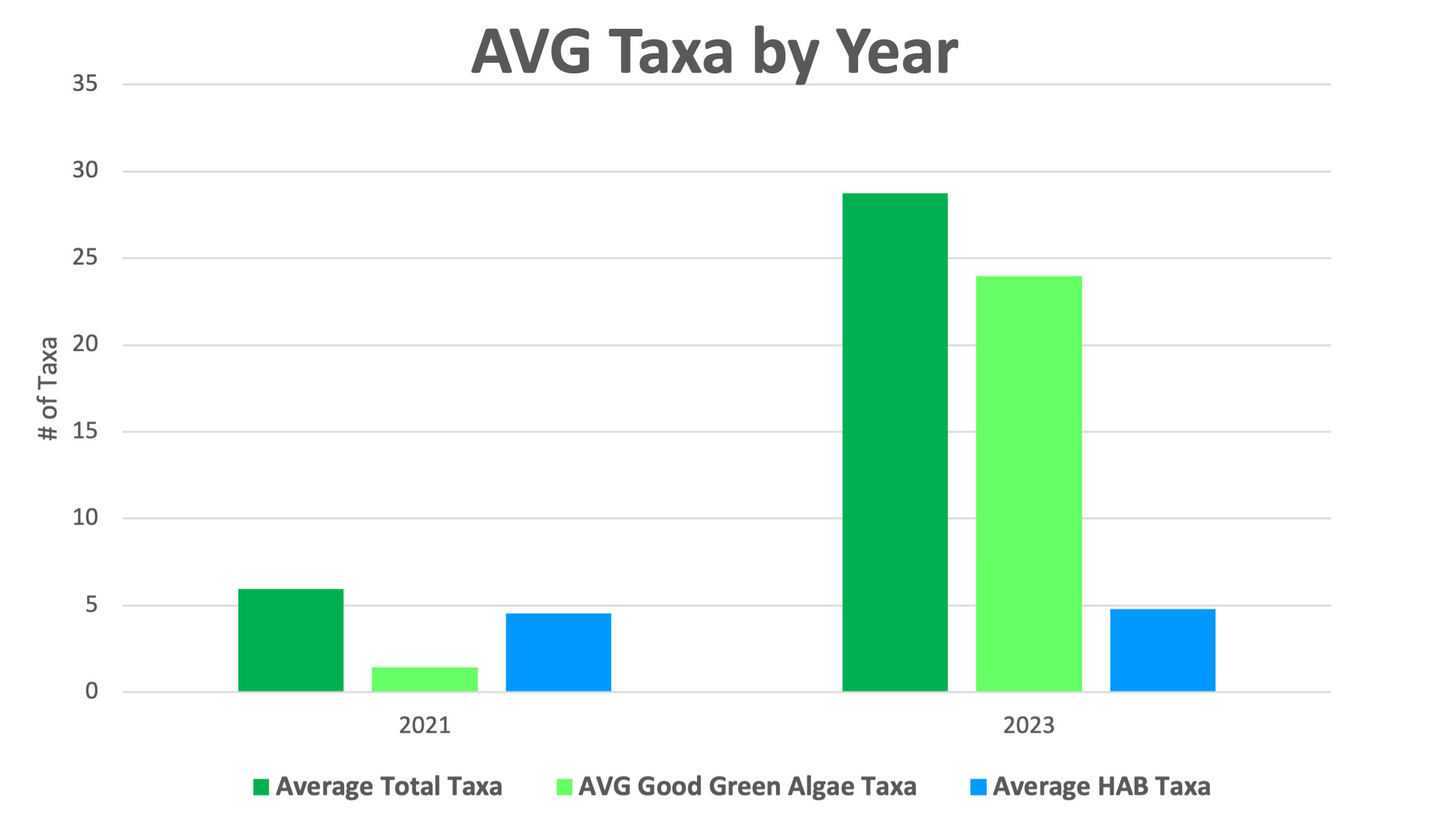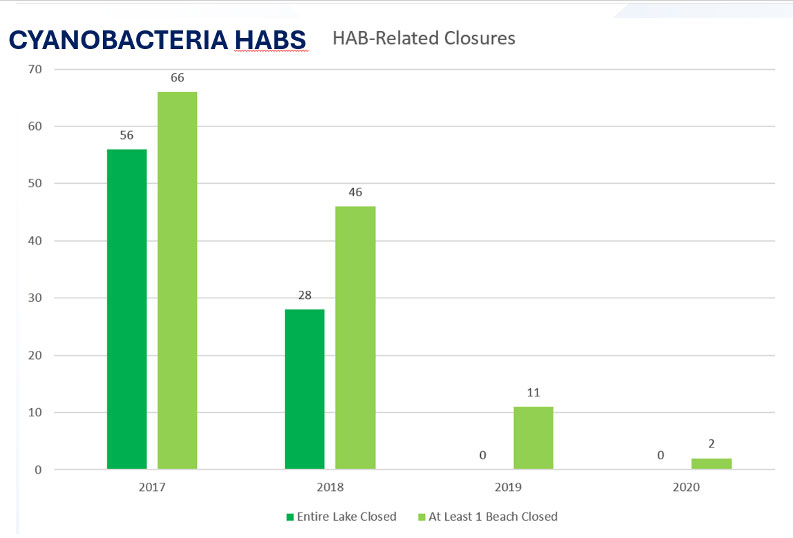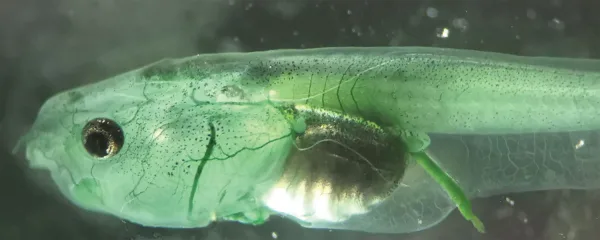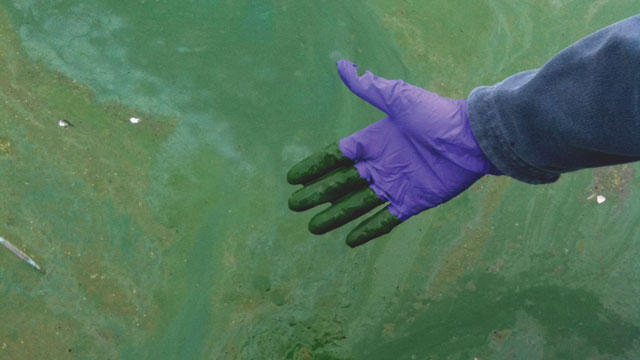TOXIC CYANOBACTERIA – HABs
HOW DOES EUTROPHICATION CAUSE TOXIC CYANOBACTERIA BLOOMS?
Eutrophication creates ideal conditions for the growth and dominance of cyanobacteria in water bodies.
As eutrophication progresses, several factors contribute to the formation of toxic cyanobacteria blooms:
1. Nutrient Enrichment: The accumulation and recycling of nutrients, particularly phosphorus and nitrogen, in the water and sediment provides an
abundant food source for cyanobacteria. As sediment nutrient levels increase, and the sediment-water interface becomes anaerobic, cyanobacteria can outcompete other phytoplankton species and dominate the aquatic ecosystem.
2. Stratification: Eutrophic water bodies often become stratified, with warm, oxygenated but nutrient-poor water at the surface and cooler, deoxygenated
but nutrient-rich water at the bottom. This is because in hypoxic benthic waters sediment nutrient recycling produces increased concentrations of phosphorus and ammonia. This stable stratification favors the growth of cyanobacteria, which can regulate their buoyancy and these access nutrients in the deeper layers.
3. Selective Advantage: Cyanobacteria have several adaptations that give them a competitive edge over other phytoplankton in eutrophic conditions. They can fix atmospheric nitrogen and utilize ammonia as nitrogen sources, store excess nutrients in their cells, and produce toxins that deter grazers and inhibit the growth of competing species.
As eutrophication intensifies and cyanobacteria proliferate, the risk of toxic blooms increases. These blooms can release potent toxins into the water, posing severe health risks to humans, animals, and aquatic life.
ARE TOXIC CYANOBACTERIA BLOOMS A PROBLEM, AND ARE THEY IMPORTANT?
Toxic cyanobacteria blooms, also known as harmful algal blooms (HABs), are a significant problem in eutrophic water bodies because they pose serious risks to public health, the environment, and the economy:
1. Public Health: Cyanobacteria toxins can cause a range of adverse health effects in humans, including gastrointestinal illness, skin irritation, respiratory
problems, and in severe cases, liver and neurological damage. Exposure to these toxins can occur through direct contact, inhalation, or ingestion of contaminated water.
2. Environmental Impact: Toxic cyanobacteria blooms can harm aquatic ecosystems by reducing water quality, depleting oxygen levels, and altering
food web dynamics. The toxins produced by cyanobacteria can kill fish, invertebrates, and other aquatic organisms, leading to a loss of biodiversity and ecological balance.
3. Economic Consequences: HABs can have significant economic impacts on communities that rely on water resources for recreation, tourism, and water
supply.
The presence of toxic blooms can lead to beach closures, fishing restrictions, and increased water treatment costs, resulting in lost revenue and increased
expenses for local businesses and governments and significant losses in lakeside property value.
Addressing the underlying causes of toxic cyanobacteria blooms is crucial to protect public health, preserve aquatic ecosystems, and mitigate the economic burden associated with HABs.
WHAT IS THE WRONG WAY TO GO ABOUT TRYING TO FIX THE PROBLEM?
A common but misguided approach to controlling toxic cyanobacteria blooms is the use of toxic chemical algaecides, such as copper sulfate or ultrasonic devices.
While algaecides may provide temporary relief by killing the visible cyanobacteria, they do not address the root cause of the problem and can actually exacerbate the situation:
1. Nutrient Release and Toxin Release: When cyanobacteria cells are destroyed by algaecides, they release their contents, including nutrients and toxins, into the water.
This sudden release of nutrients can fuel the growth of surviving cyanobacteria or other harmful algal species, leading to a rebound in blooms.
2. Resistance Development: Repeated use of algaecides can lead to the development of resistant cyanobacteria strains, making future control efforts less effective.
3. Ecosystem Disruption: Algaecides can harm non-target organisms, such as beneficial algae, zooplankton, and fish, disrupting the balance of the aquatic ecosystem and potentially exacerbating the conditions that favor cyanobacteria growth.
Another ineffective strategy is to focus solely on removing cyanobacteria biomass without addressing the underlying nutrient enrichment.
Physical removal methods, such as skimming or filtration, may provide temporary aesthetic benefits but do not solve the long-term problem.
HOW DO YOU FIX THE PROBLEM?
At CLEAN-FLO INTERNATIONAL, we take a comprehensive approach to prevent and control toxic cyanobacteria blooms by addressing the root causes of eutrophication. Our solution focuses on restoring the natural balance of the aquatic ecosystem through a combination of RADOR oxygenation technology and bioaugmentation:
1. Oxygenation: By oxygenating the water column and sediment, we create conditions that are less favorable for cyanobacteria growth and suppress and control sediment nutrient recycling.
Adequate dissolved oxygen levels promotes bio-dredging of sediment, the growth of beneficial phytoplankton species and support a healthy, diverse aquatic ecosystem.
2. Nutrient Reduction: Our bioaugmentation approach involves the introduction of enzymes to digest accumulated nutrient-rich sediment, reducing the internal nutrient recycling supply that fuels cyanobacteria blooms.
By targeting the sediment, we address the long-term source of nutrients that sustain harmful algal growth.
3. Micronutrient Supplementation: We also employ micronutrients to support the growth of zooplankton and other organisms that can graze on cyanobacteria, helping to control their populations through natural predation.
By stimulating the productivity of the food web, we promote the natural resilience of the aquatic ecosystem against cyanobacteria dominance.
Our holistic strategy addresses the underlying causes of toxic cyanobacteria blooms, providing a sustainable and environmentally friendly solution to the problem of HABs in eutrophic water bodies. By restoring the natural balance and resilience of the aquatic ecosystem, we aim to create long-term protection against the risks posed by toxic cyanobacteria.

AVG-Biovolume-by-year-2w
Figure 1 shows that Clean-Flo decreased the overall biovolume in this lake in Missouri WHILE diversifying the mix of HABs vs non-HABs species

average-taxa-by-year-2w
Figure 2 Clean-Flo dramatically increased the good green algae and total taxa while not allowing HABs to flourish.

phytoplankion-chart-edit
A large lake in NY was experiencing regular lake and beach closures before Clean-Flo’s intervention. We started treating the lake in 2018 and by 2020 eliminated all of the full lake closures and nearly all the beach closures.
Download the Lake Management ACTION Plan E-Book
Ready to explore how oxygenation can transform your lake? Download Clean-Flo’s Lake Management ACTION Plan E-Book to learn more about our innovative solutions, real-world results, and how we can help restore and protect your lake.




